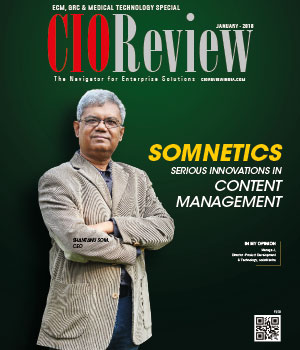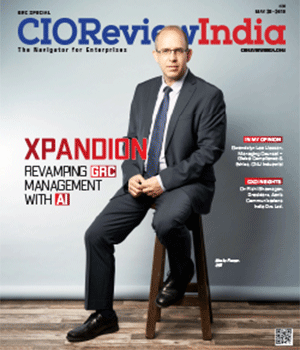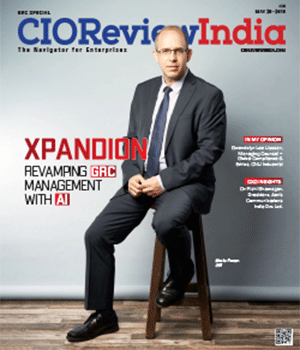
Digital Transformation in Traditional FMCG Retail Giants
Samrat Banerjee, Senior Vice President - IT & CIO, Emami Ltd
 Samrat Banerjee, Senior Vice President - IT & CIO, Emami Ltd., in an engaging conversation with CIOTechOutlook, explained methods that traditional FMCG companies can drive digital transformation without disrupting core operations. He elaborated on balancing traditional infrastructure with modern cloud solutions, global D2C and e-commerce model expansion, and the increasing need to engage with digital partners. He also underscored innovation hubs, startup collaborations, and acquisitions for business agility, and maintaining alignment with evolving consumer expectations in today’s fast-evolving market.
Samrat Banerjee, Senior Vice President - IT & CIO, Emami Ltd., in an engaging conversation with CIOTechOutlook, explained methods that traditional FMCG companies can drive digital transformation without disrupting core operations. He elaborated on balancing traditional infrastructure with modern cloud solutions, global D2C and e-commerce model expansion, and the increasing need to engage with digital partners. He also underscored innovation hubs, startup collaborations, and acquisitions for business agility, and maintaining alignment with evolving consumer expectations in today’s fast-evolving market.
As traditional FMCG and digital giants embrace digital transformation to stay competitive, how can they balance legacy systems with the modern digital infrastructure without disrupting operations?
The transition involves two key components. The first transition is a shift from traditional on-premise deployment to cloud-based solutions. Historically, FMCG companies maintained their entire infrastructure on an on-premise basis. The adoption of cloud computing began with ancillary applications and then expanded to business applications. Initially, there were significant concerns regarding data security, information security, resilience, and scalability. Once these uncertainties were effectively addressed, organizations began to migrate their core infrastructure to the cloud. Organizations cannot disrupt their current operation hence, this transformation is typically executed in a phased manner and in the final stage core business applications are transitioned to the cloud.
How are legacy FMCG companies reimagining their go-to-market strategies in the face of rising D2C and e-commerce models?
Legacy FMCG companies are progressively pursuing e-commerce. Two to three different business models are being explored in this regard. The first business model is working with e-commerce platforms such as Amazon, Flipkart, Myntra, Swiggy, Zepto, etc. Traditionally, sales were routed through distributors in conventional, generation-based operations. However, the significance of the e-commerce channel as a distribution channel has increased for FMCG companies. Currently, approximately 13 percent of business is generated through e-commerce channels, whether through D2C or aggregator platforms.
Standard D2C growth appears to be quite modest, as consumers generally prefer platforms such as Amazon, Big Basket, or Swiggy due to the variety and convenience they offer. Hence, companies are increasingly leveraging white-label D2C platforms for brand-building purposes rather than direct sales. Another strategic approach involves upgrading the traditional distribution model by leveraging analytics and Artificial Intelligence to empower companies to remain competitive with D2C and E-commerce partners.
Legacy FMCG companies are partnering with startups to accelerate digital innovation. What governance and alignment mechanisms are crucial for these collaborations to be successful?
Digital innovation can be classified into two dimensions: technological innovation and business model innovation. Many firms are partnering with startups since startups may not have much experience in scaling activities or many use case references, but typically they tend to have innovative and transformational ideas. Another approach involves acquiring native digital companies operating within the same domain. This implementation strategy enables organizations to adopt existing market innovations and integrating them into their traditional processes, thereby accelerating the digital transformation process. Another model being adopted by multinational corporations in the CPG and FMCG sectors -involve the establishment of innovation hubs for the startup ecosystem within their kind of hierarchy or organization.
What strategic digital initiatives are traditional FMCG companies implementing to meet evolving customer expectations?
One of the approach is to collaborate with aggregators such as Amazon and similar platforms, leveraging as much information as possible from them, then analyzing this data through technology and human expertise to draw inferences and accordingly redesigning your product portfolio, pricing, promotional activities, and brand visibility initiatives. Collaborations may begin in the form of subsidiary arrangements or minority shareholdings, with the potential for gradual acquisition over time. The goal is to integrate such brands into the company’s portfolio. Hence, aggregator partnerships and brand acquisition are two primary strategies for business growth and digital expansion.
CIO Viewpoint
Why Foolproof Facial Recognition Is Key Against...
By Joseph Sudheer Thumma, Global CEO & MD, Magellanic Cloud
National Technology Day 2025: Powering Progress...
By CIOTech Outlook Team
Aligning IT Roadmap with Business Objectives: A...
By Subhash singh Punjabi, CISO & Head Enterprise Architecture, Deepak Fertilisers & Petrochemicals Corporation Ltd
CXO Insights
By Suresh V Menon, Principal Consultant, Six Sigma and Strategic Management
GDPR and the Right to be Forgotten: Lessons for...
By By Milind Borate, CTO, Druva
A Practical GRC Solution for a Metals Enterprise










